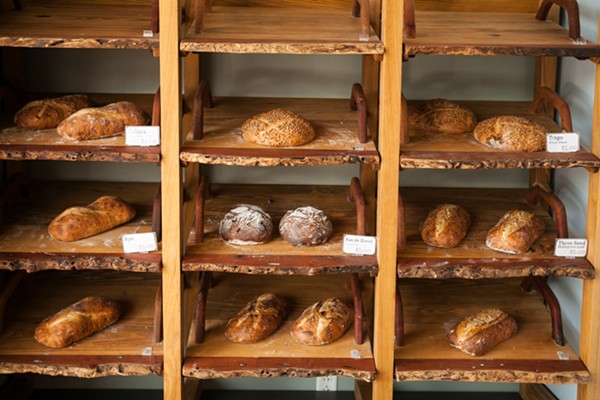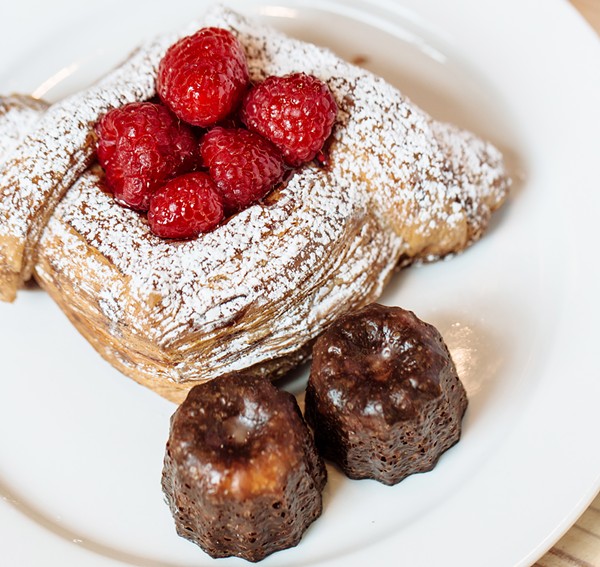Here’s the short story: When the Spaniards invaded Mexico, they brought along with them a taste for bread, which meant that they had to plant wheat. (Wheat, BTW, was also necessary for the production of communion wafers.)
The first wheat bread “came out as a tasteless lump,” according to one source. As the story goes, it took someone to start dunking the lumps in hot chocolate to make them palatable to invaders and natives alike.
When the Spanish were kicked out of Mexico in 1821, the French apparently rushed in, bringing bakers with them, and their influence — spurred by the rapid acceptance of baguettes and other breads, along with sweet pastries — had an almost immediate impact on the output of Mexican bakers who took the art and added their own touches and flourishes. It is said that there are as many as 2,000 different kinds of breads and pan dulces in Mexico today.
In between the arrival of the first French and the brief installation (1861-1867) of the Hapsburg Emperor Maximilian, there was a prior French military intervention colorfully called The Pastry Wars — which we won’t go into except to say that it did not involve French and Mexican troops tossing tarts at one another. French culturo-culinary influence culminated in the early 1900s with the dictatorship of Francophile fanboy, Porfirio Díaz.
Here’s the longer part:
According to Sylvain Nykiel of La Boulangerie and Saveurs 209, whole French villages, spurred by the devastation of vineyards due to the phylloxera louse, emptied out and hit the seas for Mexico. “Bread to the French is like rice for the Chinese: you have it daily or die,” said Nykiel, his French baker Guillaume Boulard nodding in assent. But due to the effects of altitude, temperature, water, the type of wheat already planted … the French themselves had to adapt their breads to local conditions.
In time, some pastries such as the flaky palmier were adapted outright as orejas, la galette des rois (king’s cake) became the rosca de reyes, croissants begat cuernos—at least in form, and baguettes spawned bolillos and teleras. But Nykiel says in the end “everybody likes the breads they do,” so French output remained fairly traditional while Mexican bakers felt free to improvise. Boulard’s traditional baguettes, BTW, are the local standard in both yeasted and sourdough format, and the pastry selection includes such temptations as the fluted canalé, and, currently having a moment, the coiled and sugary kouign-amann.
Counting two French bakers ( though not always present at the same time, according to the order-taker) Common Wealth Coffee House is the city’s other resolutely French bakery — no baguettes, alas, but an array of goodies such as the double-threat almond-chocolate croissant, the pain au chocolat, and the spiky veinnoise au Nutella — a must-try, as are the proper, plain croissants.
Local bakers can exhibit French influence without going through Mexico or coming straight out of France, of course; we have only to look at justly celebrated Bakery Lorraine or newer enterprises such as C’est la Vie. But it’s useful to investigate a bakery such as La Panaderia. The Cáceres brothers, David and Jose, are Mexican restaurateurs/bakers who first established a business in Mexico City before opening on upper Broadway. “We still call some rolls ‘French’,” says José, who works the floor at the shop.
David, the baker, emerges from the back to give a guided tour of the pastry display relating every item to its origins in French-inspired brioche dough (most pan dulces — including their rosca de reyes) or laminated dough (flaky, jam-filled empanadas, for example). The breads are all beautiful in their well-lighted trays, most exhibiting a kind of size and perfection not normally found in traditional panaderias/pastelerias hereabouts. But David Cáceres seems most proud of his tequila-laced almond croissants — one of the few instances of an otherwise unmodified French product being cross-pollinated with a Mexican touch.
Standing in for the more- traditional Mexican bakery is Bedoy’s — “since 1961.” At the Hildebrand outlet, I had a conversation with the woman behind the counter that was sparked by the elotitos, a pan dulce decorated to look like an ear of corn. “People think that since these look different, they also taste different,” she says, pointing to several trays in the case behind her. “But they are all the same; it’s just the shape.” And with the emblematic corn decoration we have certainly left the French far behind, just as we do with the seasonal Day of the Dead breads Bedoy is famed for. The dough may hark back to brioche, but the crossed bones and other traditional shapes are puro Mexicano. A look at the pastry case at Mi Tierra or El Panifico, to mention two more, will only confirm how far the art has come.



